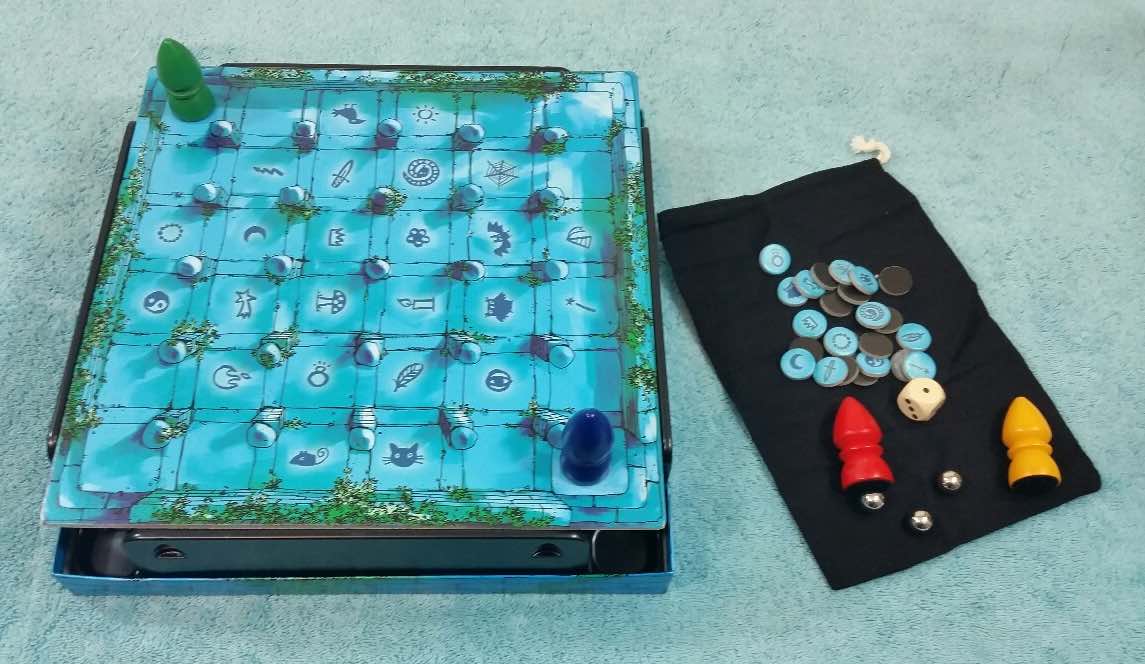 Join me today as I review two fun games for the young and the young at heart. First up is an excellent memory building game called The Magic Labyrinth. Then it’s on to visit The Enchanted Tower. I didn’t know what to expect when I first received these games, but both proved entertaining. Whether you’re looking for something to help your child pass a rainy afternoon, to keep him or her occupied over the weekend, or to fill the hours of a sleepover among friends, these games are ready to go at a moments notice! Keep on reading if you’d like the full picture.
Join me today as I review two fun games for the young and the young at heart. First up is an excellent memory building game called The Magic Labyrinth. Then it’s on to visit The Enchanted Tower. I didn’t know what to expect when I first received these games, but both proved entertaining. Whether you’re looking for something to help your child pass a rainy afternoon, to keep him or her occupied over the weekend, or to fill the hours of a sleepover among friends, these games are ready to go at a moments notice! Keep on reading if you’d like the full picture.
The Magic Labyrinth
The first game I tested was The Magic Labyrinth. This fun game, according to its box, is meant for those from 6 to 99. I guess if you’ve already passed the century mark, you’re simply out of luck! The game is designed for 2 to 4 players, and, much like the classic card matching memory games we all grew up with, The Magic Labyrinth also has a memory component that will help kids to develop their memorization skills.
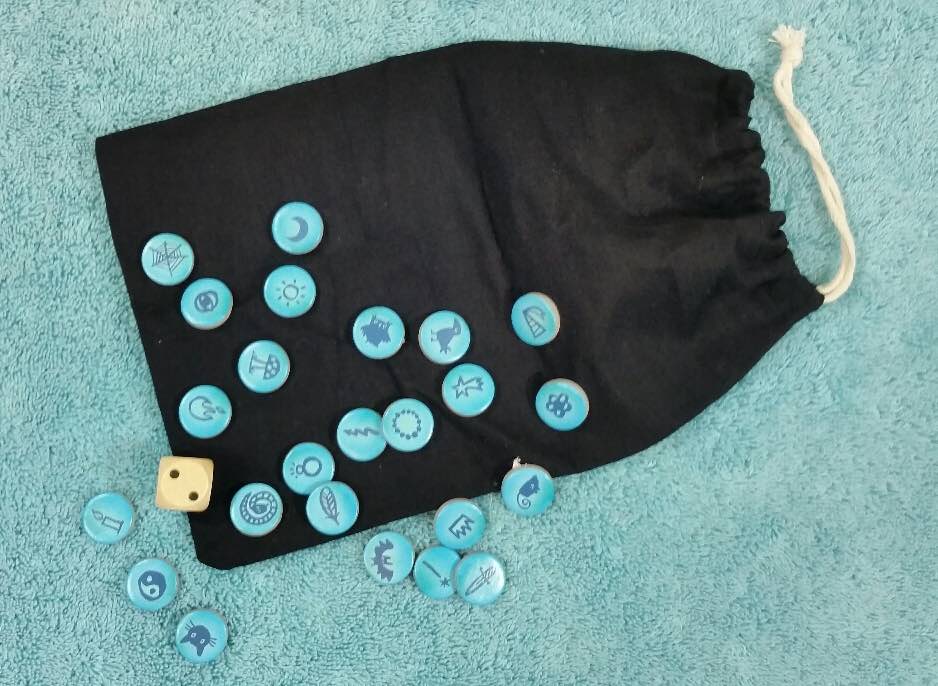
The objective of the game is to collect 5 of the game’s 24 magic symbols. The first player with 5 symbols is the winner. These symbols consist of things like a star, a mushroom, a feather, and over 20 others. They are all unique, and they a are also each reproduced on the main playing surface of the game board. There is also a strange 6 sided die that only goes as high as 4. This is because the 2 and the 3 are each duplicated on 2 sides of the die, thus limiting the number of spaces you can move in any given turn.
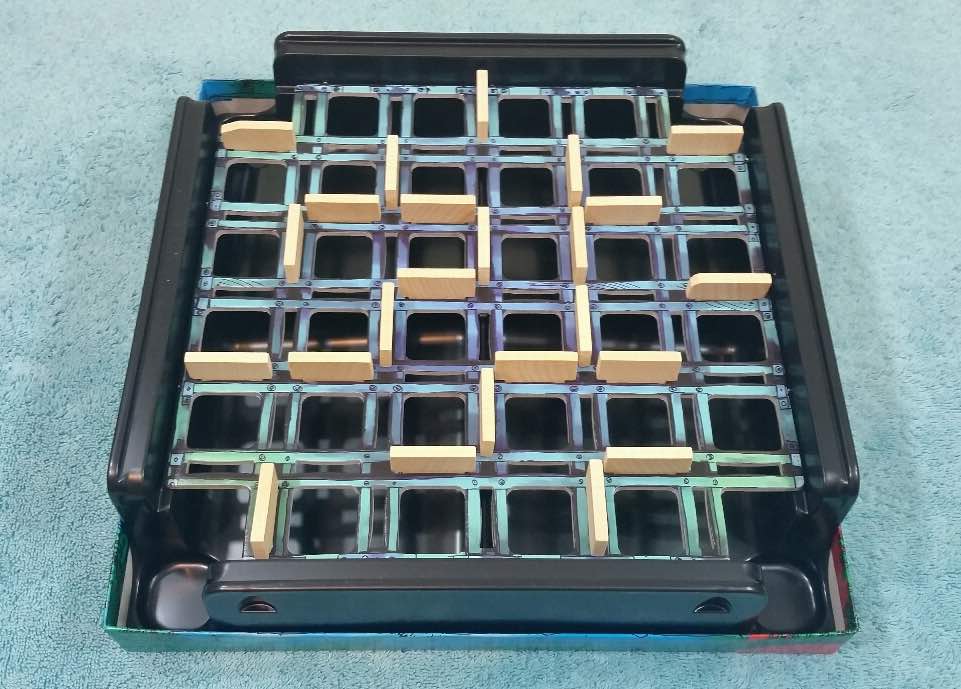
Included in the set are 24 individual wall pieces, of which you may use the entire set (for a really difficult game) or a lesser quantity. You use these wall pieces to construct a maze, or labyrinth, underneath the main playing surface on a secondary game board called the labyrinth, but you must ensure that every space on the board is accessible from at least one side. With the walls in place and the main board (referred to as the floor plate) placed on top, such that you can no longer see where the walls are located, you spin the board around several times to ensure that nobody has the advantage of knowing where the walls are placed. While doing so you also sing a short magical chant.
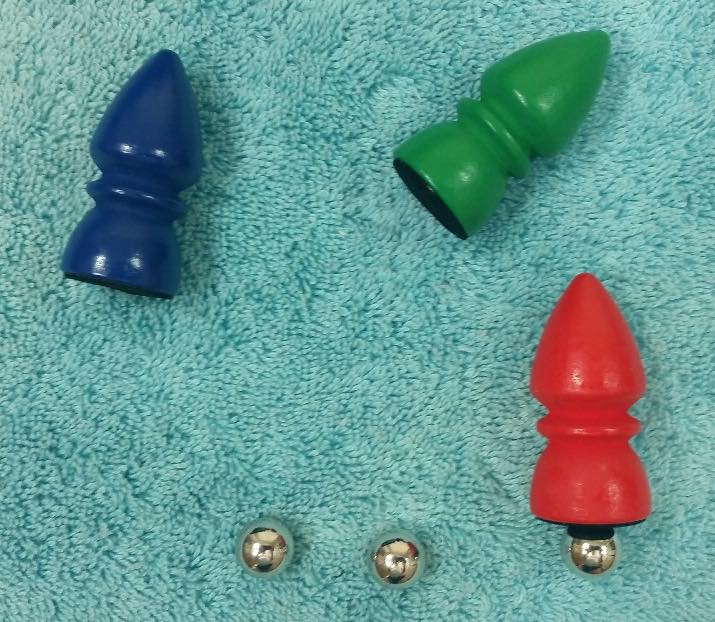
The individual players then place their magicians (game pieces) in different corners of the board and place a metal ball bearing (included) on the bottom of their magician underneath the floor plate. The ball will stay in place due to a magnet in the magician that holds it tightly to the bottom of the board. This bond will remain in place for as long as you avoid places in the maze where a hidden wall is constructed beneath the board. When you attempt to cross one of the labyrinth’s hidden walls, your magnet will fail and your metal ball bearing will roll to the nearest corner of the game board.
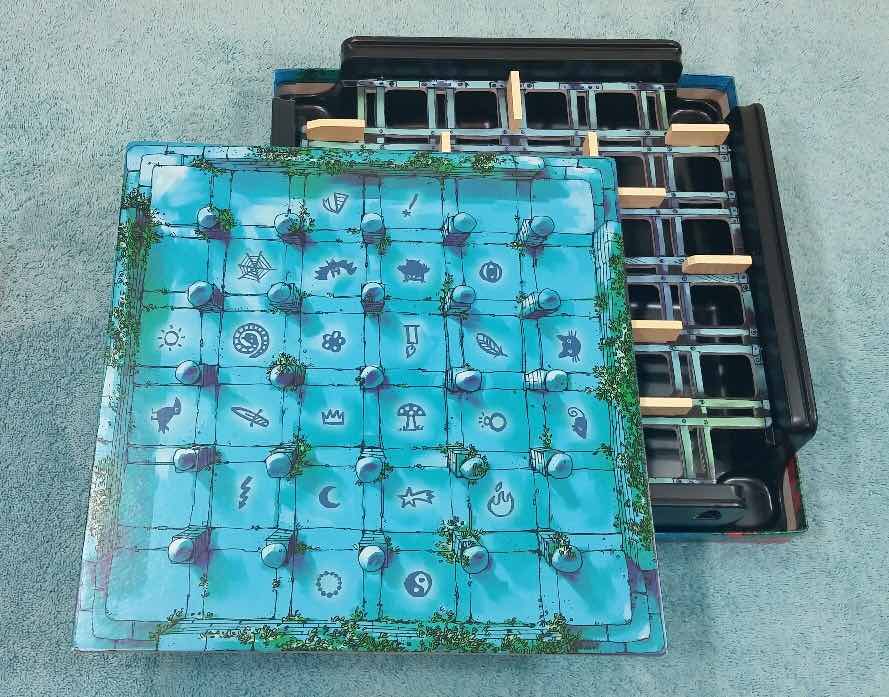 When play begins, if one proceeds to roll a 3 with the die, he or she is then allowed to move 3 spaces on the board, which is laid out in squares (just like a checker board). One is never allowed to move diagonally. Most, but not all, of the squares on the board are labeled with the same magic symbols that also exist in individual cutout form. The cutout symbols are placed in the black magic bag (also included) and drawn for individually by the participating players. The symbol that you draw must then be reached by maneuvering through the maze, but it you try to move through one of the hidden walls, your magician will become separated from the ball bearing and you will have to return to your corner of the board. It is often very difficult to reach your specified magic symbol quickly, but by remembering where you’ve run into trouble with hidden walls, you can eventually learn the quickest safe path to the symbol and collect your prize. The first player to collect 5 magic symbols is the winner!
When play begins, if one proceeds to roll a 3 with the die, he or she is then allowed to move 3 spaces on the board, which is laid out in squares (just like a checker board). One is never allowed to move diagonally. Most, but not all, of the squares on the board are labeled with the same magic symbols that also exist in individual cutout form. The cutout symbols are placed in the black magic bag (also included) and drawn for individually by the participating players. The symbol that you draw must then be reached by maneuvering through the maze, but it you try to move through one of the hidden walls, your magician will become separated from the ball bearing and you will have to return to your corner of the board. It is often very difficult to reach your specified magic symbol quickly, but by remembering where you’ve run into trouble with hidden walls, you can eventually learn the quickest safe path to the symbol and collect your prize. The first player to collect 5 magic symbols is the winner!
This game is really quite fun and inventive, and I enjoyed playing it with my wife. We used the entire set of 24 wall pieces though, and this leaves very little room for error when maneuvering through the maze. My wife won the game, but we both had fun playing. The Magic Labyrinth is meant to lest in the neighbourhood of 15 minutes, meaning you can play several games during a rainy afternoon if you like. However, using all of the wall pieces could prolong the game considerably. All in all I definitely recommend this game—particularly to those that are fascinated by magical fantasy realms like those of Harry Potter.
The Enchanted Tower
The second game I tested is called The Enchanted Tower, and it is designed to be played by either 2 or 4 (not 3) players ages 5 and up. You can either play one-on-one with a friend, or in two teams of two. This game is a bit more complex than The Magic Labyrinth, so we’ll just cover the basics of how it works rather than going into full details. It’s not at all difficult to understand or play—it just has a few more rules than the other game.
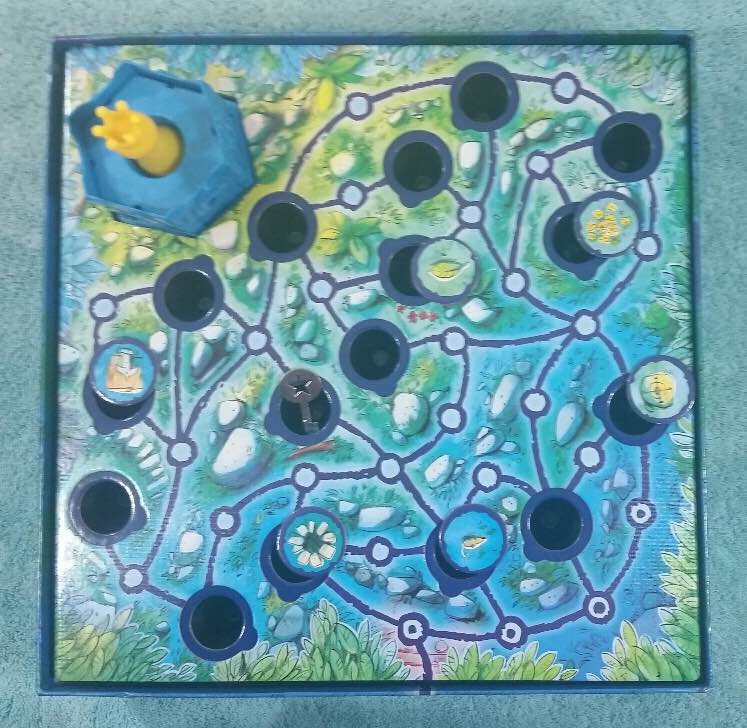
The first thing to note is that the objective of the game is to find a hidden key and free the Princess who is trapped in the tower. The key is hidden in one of the 16 covered holes on the game board. These holes are covered by round cutout (pop out) tiles, and the two main character pieces are magnetized on the bottom so that when one of them steps on the correct tile, the key will jump up to meet the magnet and you will hear a clack, which lets you know you’ve found the key.
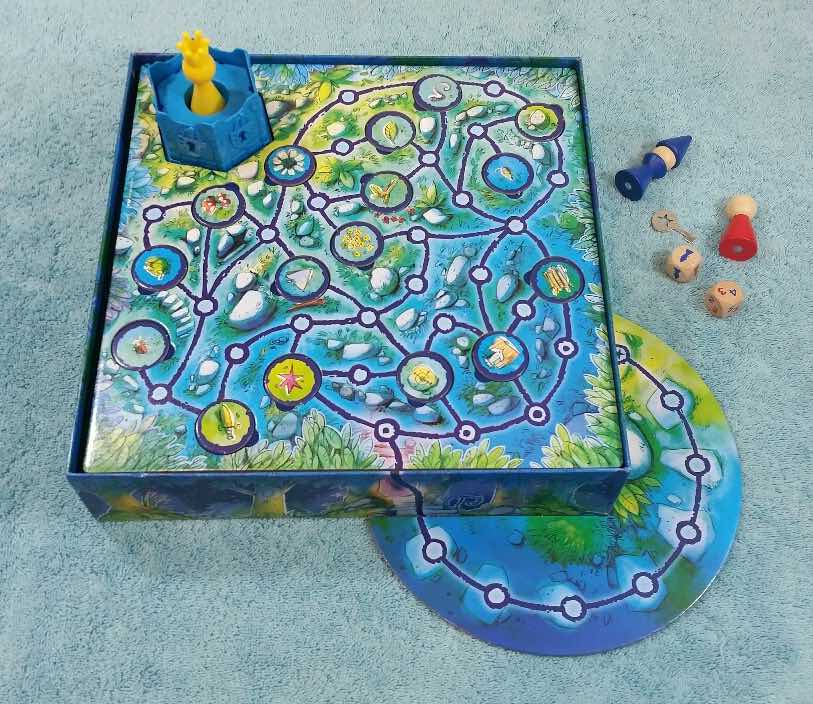
Alternatively, if you play the role of the Sorcerer, your job is to get to and retrieve the hidden key first (before Robin, the hero, finds the key and frees the Princess) and try to free her yourself. In other words, you either play the role of the brave hero, Robin, or the cunning wizard, whose name is Ravenhorst But either way, the objective of the game is to free the Princess first. Whichever individual or team accomplishes this task is the winner.
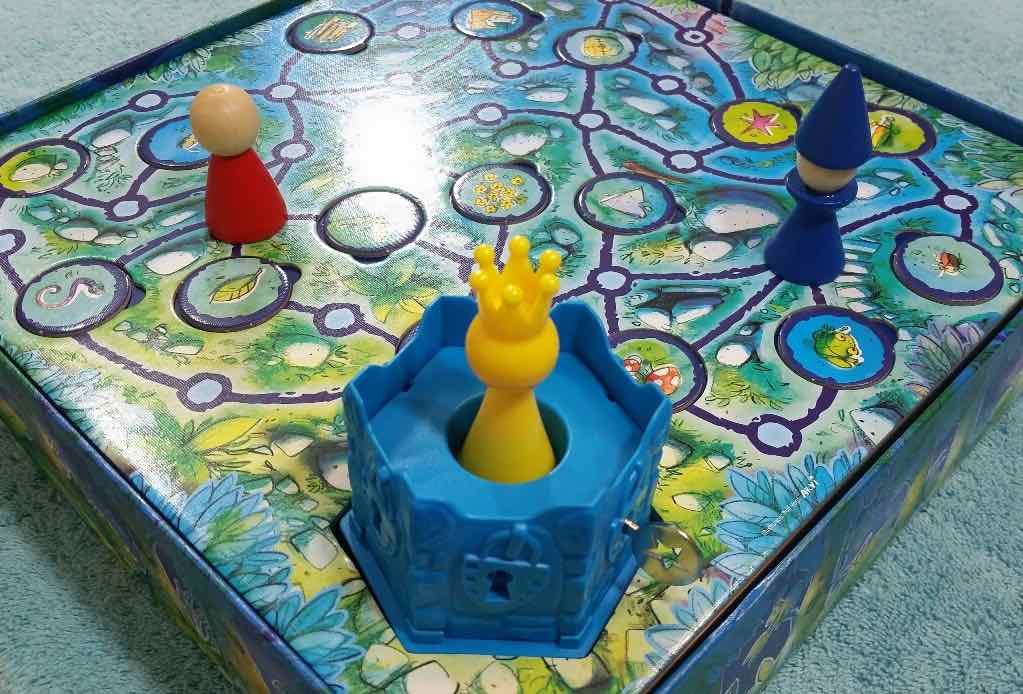
Interestingly, the Sorcerer is the one that initially hides the key (and always knows where it is). He (or she) will not necessarily get to the key first, however, as Robin is given a head start on the board. If the hero does find the key, an attempt is then made to free the Princess. Unfortunately, there are several different locks for you to try out, and only one of them will free the Princess. If you get the wrong lock on your first attempt, the Sorcerer hides the key again and the game begins anew. Keep on trying though, because with a little luck the hero can unlock the correct lock before the Sorcerer does. Also, always remember which locks have been attempted as the game goes on, otherwise you could waste an opportunity to win by choosing a lock that’s already been attempted.
It’s a pretty basic concept, but there are some additional rules that do complicate things a bit. For example, one rule says that there’s a specific path that absolutely must be followed at all times. No shortcuts allowed!
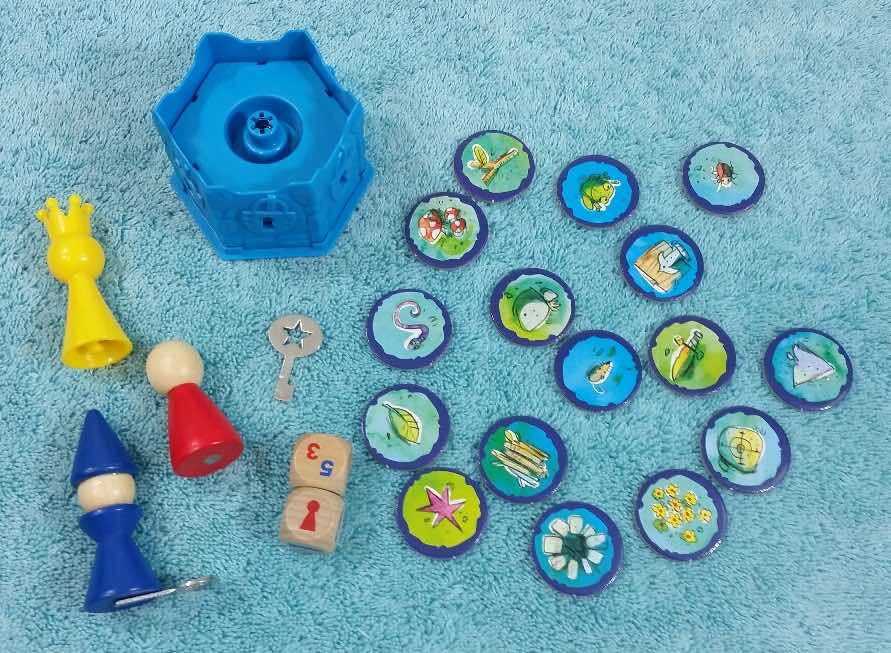
A number of different pieces are included with the game, including the board itself (2 pieces – one large square board and one smaller, partially circular piece), one Princess figure, one Sorcerer figure, one Robin figure, one tower, two keys (there’s a spare), 16 tiles (that cover the holes), and two dice (one to determine the number of spaces in a move and one to determine which character gets to play first). The Princess is placed in the tower for the duration of the game. Once the key is inserted into the correct lock, she will spring free like a Jack-in-the-Box. The tower is designed to be placed within the game board in a variety of different ways (facing different directions). This way, the correct lock may well be in a different position in each game. Total play time is expected to be roughly 25 minutes.
Overall, this is quite a fun game to play, though I think that The Magic Labyrinth was my favourite of the two. Either way though, kids with big imaginations are sure to love both, and I do recommend them equally. They’re a really great way to fill an afternoon, and, thanks to the memorization component, they may even have some educational value—particularly in the case of The Magic Labyrinth. Until next time, have an excellent week!

